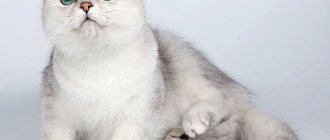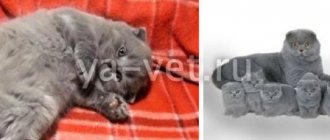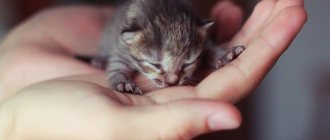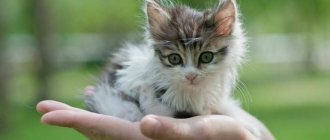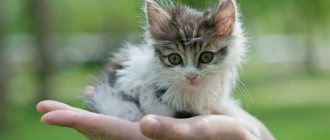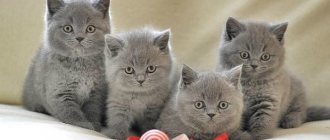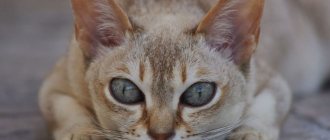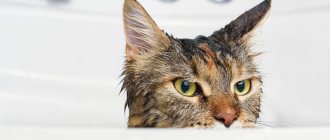8921Administration
Along with nutrition, caring for a Scottish Fold kitten and its proper organization is one of the first places in importance. This is necessary to ensure that your Scottish kitten always remains healthy, playful and does not need additional veterinary care.
Care consists of proper nutrition, organization of sleeping space, availability of necessary toys and scratching posts, as well as a timely cleaned toilet with the correct filling. If all these requirements are met, caring for a Scottish kitten will not take much of your time , he will know which territory is his own and will not be mischievous in the house.
On a note
Owners of this breed note that the Scottish cat is quite calm and balanced and can spoil or do some kind of mischief only if the owners do not adhere to a sufficient level of cleanliness and care and do not provide everything necessary for the pet’s life.
© shutterstock
An integral part of the care is also a planned, independent examination of the ears and eyes, timely trimming of nails and comprehensive care for the pet’s coat, as well as a visit to the veterinarian for vaccination and carrying out all necessary procedures according to the schedule.
Organizing a personal space for a kitten
In order to understand how to care for a Scottish cat, you need to study a little about its character and basic habits that are inherent in all representatives of the Scottish breed. Scottish cats are quite clean and not picky about grooming , but they require that everything they need is always within reach and the Scottish cat must have its own place. Where he could hide and be alone with himself.
Scottish cats are quite undemanding in terms of attention and care, they are mostly left to their own devices, they are perfect for those who are often not at home, but who want to be greeted by their beloved Scottish kitten, without suffering from a lack of attention and care due to the dense owner's work schedule. The main requirements that must be met in care are:
- availability of a clean toilet;
- timely and proper nutrition;
- having your own bed;
- scratching post
How to choose the right food for a 2 month old Scottish Fold kitten
Breeders advise feeding your pet the same food that its mother consumed. But if the new owners do not have the opportunity to buy expensive food, then the feed manufacturer and the type of product are selected individually. Carefully, giving a small amount of food, monitor the Scotsman’s condition. In the absence of negative effects, the feed is introduced for continuous use. It is especially necessary to ensure the compliance of all microelements and vitamins in it. When eating natural products, the daily diet is varied. The pet should receive lean meat, fresh sea fish, vegetables, cereals, and dairy products. You should not feed your Scotsman potatoes, legumes, onions, pork or lamb.
Organization of a toilet for a Scottish kitten
Considering that representatives of this breed are quite clean, proper care includes timely replacement of litter and its correct choice. The most optimal option is to use the litter that was in the nursery, so the Scottish kitten will not have to adapt and will quickly adapt to the new place of residence and toilet. And the character of Folds is such that he can shit or go to the toilet in the wrong place only if he does not find his own tray or the toilet was not cleaned on time.
If a Scottish kitten went to the toilet in the wrong place, under no circumstances should you punish it, as this will be regarded solely as aggression and will not lead to any results.
In this case, it is recommended to thoroughly clean the place where the kitten went to the toilet and additionally show him where the tray is so that he can find it on his own next time.
© shutterstock
What should you not feed lop-eared and straight-eared kittens?
What Scottish Fold and Straight-eared kittens enjoy eating does not always coincide with what is good for them. Learn the list of do's and don'ts.
| PRODUCT | PECULIARITIES |
| Sweet | It is not allowed in any quantities. If a cat asks for sweets, this means that he is interested in something else in the product, because cats do not have receptors that recognize sweet taste. Don't buy into your cat's requests: he can develop diabetes very quickly. |
| Salty | We don’t add salt to kitten food at all. We also don’t serve salty products from the store. Salty foods can cause kidney and bladder problems in cats, which Scots are already prone to. |
| Spicy | Kittens should not have spices at all. They upset digestion. |
| Onion garlic | Likewise, garlic and onions can cause serious problems. |
| Chocolate | Even if chocolate is not sweet, as it should be according to the classics, it is still under no circumstances allowed for a cat: for an animal it is poison. |
| Coffee | Likewise, coffee is poisonous to cats. If your cat asks for coffee, he may be attracted to the milk you add to the drink. |
| Milk | Kittens are supposed to eat fermented milk, but milk, which contains lactose, causes gas and indigestion in cats older than 3 months. Owners often don’t notice this, but in fact the animals don’t feel well after drinking milk. If you really want to feed your kitten milk, pay attention to goat milk or special ready-made milk formulas for kittens. After 3 months, cats do not need milk at all. |
| Marinades | Kittens cannot eat anything marinated, not just meat. This applies to any conservation. |
| Smoked | Just remember that it is poison. |
| Bold | Excessively fatty and fried foods, no matter whether it is meat or not, are prohibited. The kitten's pancreas cannot withstand such nutrition. Even sour cream for a Scottish Straight and Scottish Fold kitten may be too fatty a food, so nutritionists do not recommend it. |
| Fatty pork | Pork with hanging pieces of lard is not allowed for cats. But sometimes a small piece of the lean part is allowed. Just keep in mind that pigs have Aujeszky's disease, which is fatal to cats and can be transmitted through raw meat. Therefore, it is better to bake pork at the most gentle temperature possible, rather than serve it raw. |
| Canned food | Any canned product is always generously supplied with salt, spices and preservatives. This in itself is harmful even for humans, not to mention the digestive and urinary system of a kitten, which is much worse adapted to such food than ours. |
| Citrus | As a rule, cats cannot tolerate lemons, oranges, tangerines and other citrus fruits. But there are exceptions. Citrus fruits contain pungent essential oils that attack cats' keen sense of smell. Plus, eating them can cause indigestion. |
| Fruits | The digestive system of cats is not adapted to eating fruits and berries, so they can cause stomach upset. |
| Mushrooms | Mushrooms are too heavy a food. In addition, they can cause poisoning. |
| Potato | Potatoes are pure starch, which is very difficult to digest and is poorly absorbed by the cat’s body. Recently, cat nutritionists have allowed the consumption of only a few grams of potatoes per day. |
| Beans | Peas, lentils, soybeans and other legumes are prohibited because... This is too heavy food for a kitten, plus they cause fermentation. |
| Flour | All flour products, including bread, are harmful to kittens and have no nutritional value for them. Instead, it is better to purchase special yeast for cats in the form of a supplement. |
Feeding with ready-made food involves using mixtures created at the factory in the form of pastes, pieces of jelly, canned food and dry pads. Typically, such mixtures contain everything that is included in natural food, but it is specially processed for long-term storage. Draw your own conclusions. But in any case, you cannot feed cheap mass-market food such as Whiskas, Kitiket, etc. According to veterinarians, cheap cat food is made from who knows what, so consuming it will lead to illness. Veterinarians recommend only super-premium and holistic food.
Supporters of ready-made food put forward the main arguments in favor of such nutrition that, firstly, the substances in the food are already balanced, and, secondly, such nutrition is easier for the owners: buy it, take it out, pour it in.
Please note that it is not advisable to mix natural food and ready-made food - choose one. And the brand of food should also always be the same. Otherwise, it is very difficult to create a balanced menu, because... Each food has its own characteristics.
Article continues after advertisement
If dry pads are on the menu, the cat will need increased consumption of fresh water. Buy your cat a special fountain to encourage him to drink more.
Porridge for Scottish kittens
Porridge for Scottish kittens is not a recommended diet if it includes grains and beans. Therefore, the answer to the question of what kind of porridge Scottish kittens can eat is - none. Of course, many are accustomed to feeding cats porridge and see nothing wrong with it. But, if we are talking about ideal nutrition, then such a component is unacceptable.
Scratching post and toys
Mandatory care attributes that any Scottish kitten should have are:
- one or two scratching posts that will allow you to sharpen your claws and clean them in a timely manner - as the basis of care;
- various types of toys in the form of balls, mice, fishing rods with feathers and other entertaining toys that you and your pet will enjoy.
Having these toys will not only amuse your animal, but will also allow him to have fun while you are away. And if you wish, you can always play with your pet without thinking about where to get a ribbon for playing or a candy wrapper in order to attract a Scottish kitten.
© shutterstock
Organizing your own place
Comprehensive care for a Scottish cat includes organizing your own place for the kitten and preparing special toys. These include not only a scratching post, but also many small toys in the form of mice, balls, and various fishing rods, which not only develop the Scottish cat, but also allow you to protect your personal belongings from the kitten’s harm.
The representatives of this breed themselves, Scottish cats, are quite well-mannered and will not play with the personal belongings of their owners, but still a large number of toys will only please your pet. A prerequisite will be the purchase of a house or bed , which will become its own personal space for your Scottish cat.
© shutterstock
Carrying out hygiene procedures
Organization of special care for Scottish Fold kittens includes:
- timely bathing;
- cleaning and examining the eyes and ears;
- cleaning and cutting nails;
- mustache and coat care.
British Fold kittens especially need careful care. First of all, these are regular hygiene procedures, examination of the ears and care for them.
Considering the specific structure of the ear, special attention is paid to their cleaning, care and timely hygiene. And in order to clean the ear, you need to unscrew it and wipe it with a damp swab on the auricle.
If light-colored, odorless sulfur remains on the swab, then your Scottish kitten is completely healthy. If, when examining the ears, an unpleasant, specific odor appears, the wax turns yellowish, this indicates the presence of an infectious disease that requires urgent diagnosis and treatment by a veterinarian or insufficient care.
Claws and teeth should be in order
Caring for a cat of a breed such as the Scottish Fold also involves periodically trimming its claws. It is best to use special devices that are designed for such small pets. Nippers will allow you to get the correct cut, preventing the possibility of splitting and delamination of the claw. It is necessary to trim only the edge; in case of excessive cutting and careless wounding of the skin, the damage should be treated with peroxide. For their convenience, many owners deprive their pets of their nails altogether. However, this is extremely harmful to the animal.
If we consider oral care, then the cat does not need special measures. Nutrition is largely a determining factor. If kittens eat only dry food, no care will be required. In this case, the pet does not need to brush its teeth, since the hard granules included in such food help cleanse the surface of the teeth from plaque and strengthen the gums. Tartar removal is an important procedure for any animal, but kittens do not undergo it. In adult pets, tartar is removed in a veterinary clinic under anesthesia.
Eye hygiene
The anatomy of Scottish cats provides for a high risk of infection of the tear duct, therefore it is necessary to pay special attention to the hygiene and care of your kitten's eyes . Very often, owners of Scottish cats consider it normal for this breed to have a tear streak from the eye. However, this approach is not correct, since purulent or brown discharge from the tear duct signals that you urgently need to contact a veterinarian and clean the tear duct, because the main cause of such discharge may be infection or improper care.
It is recommended to wipe the eye from the corner and along the inner edge with a damp swab weekly, and if desired, you can purchase a special liquid for eye hygiene and care. It is also imperative to inspect the eyes every morning and, if a dark coating forms, remove it with a regular sponge.
These simple rules will help keep your pet healthy and avoid visiting the veterinarian.
Nail hygiene
You should trim your pet's nails about once or twice a month. Particular attention should be paid to avoid damaging the blood vessel while caring for your nails. For this Scottish kitten, it is recommended that he be taught to trim his nails and care for them from childhood so that he does not resist or interfere with the owner when carrying out these hygiene procedures and caring for his paws.
© shutterstock
To cut nails, it is recommended to purchase specialized scissors, which are sold in zoological stores. Also an important step in cleaning, hygiene and care of nails is the use of a scratching post, which is recommended to accustom a kitten to from a very young age.
Using a scratching post is not only fun for a kitten, but also a healthy necessity, since claws need to be renewed and sharpened - this is one of the aspects of caring for them.
Cat pregnancy
When the cat reaches sexual maturity, she can be bred. The most suitable age is 1.5 years for breeding Scottish cats at home to be successful and the kittens to be born healthy. You should also pay attention to the fact that a fold-eared cat cannot be crossed with the same breed; it is advisable to choose a straight-eared cat for this.
Such an interesting situation as the pregnancy of a Scottish cat can raise many questions among breeders. Undoubtedly, this is an important aspect of a pet’s health, so everyone needs to know the main features during a cat’s pregnancy:
- pregnancy lasts nine weeks;
- nipples swell and turn pink;
- appetite increases, more calcium should be introduced;
- fish consumption should be reduced, it has a negative effect on babies in the tummy;
- Before giving birth, a cat may meow a lot and not find a place for itself.
After birth, the kittens are nursed by the mother, and a few months later the owner takes them to the clinic for vaccination. To determine the exhibition parameters and enter these kittens into the passport, the owner can visit the Scottish Fold cattery.
Oral care
Considering that the bone and cartilage tissue of British kittens is quite fragile, it is necessary to pay special attention to the oral cavity and its care. Dental care includes regular checkups and cleaning, if necessary, to remove tartar and plaque. It is recommended to independently examine the oral cavity and teeth once a month . They should be white, without any inclusions, and the gums should be uniformly pink.
In case any wounds are found in the mouth, it is recommended to immediately contact a veterinarian who can correctly diagnose them and prescribe treatment. In this case, it is recommended to switch the British kitten completely to soft food and exclude solid food until complete recovery.
How to properly prepare for the arrival of a kitten?
For the first 2 months, newborn Scottish kittens live with their mother, who provides the babies with food and also instills the correct habits - going to the litter box, sharpening their nails on a scratching post, caring for their fur. During this period, it is possible to determine the presence of congenital genetic pathologies, such as osteochondrodysplasia. Kittens born with this disease have a disproportionate body, thickened, inactive tails, and enlarged joints. Such a baby will not live an ordinary life, but you can save him by promptly contacting a veterinarian who will prescribe treatment. An animal raised with affection and care develops and plays no worse than a healthy one, because if its owners love it, this means a lot for the well-being of a Scot.
At the age of 2-3 months, small kittens are able to eat food on their own, take care of their fur, and go to the litter box. Kids begin to actively explore the world around them, get acquainted with new animals and objects. It is from this age that kittens should begin to be raised and, if necessary, trained. But before you get a little Scotsman, you should prepare for his arrival. To do this, you need to purchase dishes for food and water, a tray, litter, a cat house or basket, a carrier, and toys. Don’t forget about hygiene items, which include a comb, toothbrush, scissors, as well as products such as shampoo, toothpaste, and essential veterinary medications.
Grooming
Considering the innate cleanliness of British cats, to care for their fur you will need to organize a whole ritual, which will include:
- bathing;
- combing;
- the use of special lotions.
Considering that cats of this breed have a fairly thick undercoat, it is not recommended for them to lick themselves, as the fur easily becomes matted and can clog the intestinal tract. In this regard, it is necessary from childhood to accustom kittens to regular water procedures, as well as combing after them, especially if they have long and beautiful hair.
Description of the breed
Scottish cats have very developed muscles, a powerful and squat body, and short hair. This cute creature with a plush coat has short strong legs, a powerful neck, a large round head with a formed chin and pronounced cheeks. In the Scottish Fold, a characteristic sign of thoroughbredness is small triangular ears, strongly pressed to the skull, the tips of which are directed forward and curved down due to a special crease in the cartilage.
The large and round eyes of a 2-month-old Scottish Fold kitten, the photo of which is presented in the article, often have an amber-yellow color, and sometimes match the coat color. The animal's long tail tapers slightly towards the tip. The color of the coat with a thick undercoat can be very varied: cream, black, white, blue, chinchilla, silver. All kittens are born with straight ears and only some, after three weeks of age, acquire a characteristic appearance. There can be straight-eared and lop-eared Scots in the same litter.
Adaptations
Brushes for combing are:
- wooden and plastic;
- with wide teeth or natural bristles;
- in the form of a comb or in the form of a glove.
For short-haired cats, weekly brushing with a special brush, which consists of natural bristles, is acceptable. Based on your pet's preferences, you can use a plastic or wooden brush with wide teeth. If coat hygiene is maintained at the proper level, there is no need to worry about the appearance of parasites such as ticks and fleas.
© shutterstock
Tray training
As for the toilet and toilet training, Scottish kittens are extremely clean in this regard. They master their litter box at a rapid pace. First, it is better to prepare a toilet with low sides for the baby, and when the cat gets stronger and grows up, the container can be replaced with a larger and higher one.
An important point regarding the health of your pet is the choice of filler. Silica gel is preferred among pet owners. This filler completely eliminates any unpleasant odor. In addition, cats love to dig and rustle the earth during visits to the toilet. If this option seems too expensive, you can use a more economical option in the form of wood pellets.
Nutrition rules
Feeding Scottish Fold kittens is a rather meticulous process that requires a long study and compliance with certain rules. Considering that cats of this breed are prone to being overweight, portions need to be limited from childhood and a diet should be established that will fully correspond not only to your daily routine, but will also ensure constant access to food and regular feeding.
For the most part, new owners prefer to feed the kitten the same food that was offered to it in the nursery or from previous owners.
However, this position is not entirely correct. On the one hand, the kitten will be comfortable eating what it was fed with its mother, but based on the kitten’s personal preferences and the owner’s capabilities, you can choose one of three nutrition systems:
- exclusively natural food prepared especially for the cat;
- purchase of dry food or wet mixtures, canned food;
- combination of artificial and natural food.
Diet of a kitten up to a year by month
The digestive system of small kittens cannot process many foods that are allowed for adult cats. It is advisable to consider each stage of development of the Scots in order to feed the pet in accordance with its age.
0-1
The first month after birth, kittens do not need to be fed additionally - their mother's milk is enough for them. It is very nutritious and contains antibodies that form primary immunity.
Important. A nursing cat needs to eat heavily. During lactation, her body is greatly depleted.
If kittens cannot be breastfed, you need to buy special formulas - cat milk substitutes. They are sold in veterinary pharmacies.
It is not advisable to feed babies cow's milk. It contains less fat and protein, but more lactose, which is poorly digestible. Baby food is also not suitable - it is not intended for cats.
Immediately after birth, babies are fed 10-12 times a day, even at night. By the end of the second week, the number of feedings is reduced to 8 times, and by a month - to 6 times.
The amount of mixture is determined per 100 g of kitten weight:
- Days 1-5 – 30 ml;
- Days 6-13 – 38 ml;
- 14-24 days – 46 ml;
- Day 25-30 – 53 ml.
Newborn kittens cannot lap. To feed babies, you will have to use a bottle with a nipple, a pipette or a syringe. At 3 weeks they try pouring milk into a bowl. By this time, babies are able to eat on their own.
1-2
At 1 month, Scottish kittens are introduced to new food. Babies continue to eat milk, but in the intervals between feedings they are offered:
- chopped meat;
- fermented baked milk;
- cottage cheese;
- milk porridge.
A one-month-old kitten is fed 3-6 times a day, depending on the amount of mother's milk. The volume of solid food is 100-120 g.
2-3
At 2 months, Scottish kittens are still nursing their mother, but the proportion of solid food in the diet is increasing. Usually at this age, pets are prepared for transfer to new owners. They should already be able to eat on their own and do without the help of an adult cat.
If in the future the owner plans to feed the kitten industrial food, then it is better to accustom him to it now. To do this, buy wet canned food and dry granules. The former occupy about 90% of the diet, the latter – 10%. As they grow, the amount of “drying” is increased, and the share of wet food is reduced to 30%.
Important. Dry kibble and wet food are given at different times.
At 2 months, Scottish kittens are fed 6 times a day. The volume of food is 160-180 g.
The baby's diet is enriched with grated boiled vegetables. Stop turning the meat and cut it into small pieces.
The new owner should definitely ask the breeder what kind of food the Scottish kitten was fed. Babies should not be abruptly switched from one food to another. This is fraught with disruption of the gastrointestinal tract.
3-4
The kitten is actively growing and needs more and more food. The daily amount of food at 3 months is increased to 180-240 g, and the number of feedings is reduced to 4-5 times a day.
At this age, a crucial period begins - the change of teeth, due to which the need for calcium increases significantly. To replenish reserves, the Scotsman is given more fermented milk products. The diet is enriched with vitamin and mineral complexes, which are selected in consultation with a veterinarian.
Important. A Scottish kitten is no longer fed whole milk at 4 months of age. In adult cats, it is most often not absorbed.
4-5
By 4 months, the Scottish kitten's gastrointestinal tract becomes stronger. Now you can feed the baby:
- offal;
- sea fish;
- eggs;
- greens.
The meat is cut into larger pieces so that the baby can exercise his jaws.
Pets are fed fish with caution. Some Scots are allergic to it. If a negative reaction occurs, the product is excluded from the diet.
The growth rate of the kitten slows down slightly, so the daily amount of food remains the same - about 180-240 g. The number of feedings is reduced to 4 times a day, increasing the portions proportionally.
5-9
At 5 months, the Scottish kitten continues to be fed 4 times a day with the same foods. From 6-7 months, many pets themselves refuse additional portions and smoothly switch to 3 meals a day.
Kittens begin puberty. Girls become restless, boys can show aggression. Pets often lose their appetite. But there's no need to worry. The baby's condition will return to normal as soon as the hormone levels stabilize.
At this age, many Scots are castrated. To avoid health problems, the kitten needs to be fed a little differently:
- include more fiber-rich foods in the menu;
- give up fish to avoid urolithiasis;
- limit the caloric intake of the diet, otherwise the pet may become fat.
If a Scot eats ready-made food, they buy him products from lines for neutered cats.
9-12
At 9-12 months, a kitten is considered almost an adult, but the formation of its body continues up to 2 years.
Now the pet requires less energy. To calculate the daily volume of food, a new formula is used - 3-5% of the animal’s weight. The exact amount depends on the activity and individual characteristics of the Scottish kitten.
The optimal feeding rate is calculated empirically. If after eating the pet does not move away from the bowl and meows pitifully, he is given a little more food. When your pet leaves food in the bowl, the portions are slightly reduced.
Nuances
Each of these power systems has its own advantages and disadvantages. For example, with a normal diet, it is necessary to take care of a balanced diet, including all necessary vitamins and microelements in the diet, increasing the percentage of protein and limiting the amount of carbohydrates.
In this case, your Scottish cat's digestive system will not fail and will ensure longevity for your pet.
Eating dry and wet food allows you to provide the most balanced nutrition, however, it can be addictive and may not always be of the required quality, as a result of which your Scottish kitten may not receive enough nutrients and microelements that it needs, especially during the growth period.
You can also feed your Scottish Fold kitten canned foods, but you should make sure that they do not contain large amounts of preservatives and dyes that can harm your Scottish kitten’s intestinal tract that is not yet fully formed.
Diet at 6 months: menu for neutered cats
At six months of age, most kittens undergo a castration procedure. From this point on, the pet’s diet needs to be revised, excluding a number of products from it.
After castration, the likelihood of obesity increases, so due attention should be paid to the nutrition of the Scottish Fold.
Features of feeding castrated animals:
- The menu should include foods enriched with fiber and vitamins.
- Complete exclusion of any type of fish from the diet, since it contains phosphorus and magnesium. Regular entry of these elements into the body of a castrated animal increases the likelihood of urolithiasis.
- Be sure to eat porridge. To make cereals tastier, you can add some lean meat to them.
- By-products - in small quantities, no more than once a week.
- Greens and specially sprouted trauma for cats.
- Vegetables are served only raw. Allowed: carrots, cucumbers, cabbage.
- It is recommended to give your pet low-fat beef broths several times a day.
If the Scottish Fold is on a ready-made food, you need to choose only those that are intended for sterilized and neutered animals. The feed must be of appropriate quality. Preference is given to holistic, super and premium classes.
For other kittens that are not castrated or sterilized, the menu remains the same, only the number of meals per day is reduced.
Supplements
After receiving the doctor’s recommendations and passing all the necessary tests, you can include in the diet special vitamins and supplements, microelements that will significantly strengthen the skeletal system, provide the body with all the necessary substances and at the same time allow you not to worry about ensuring that the special food prepared for the kitten is saturated , for example, vitamin Omega 3 or contained a large amount of protein.
The advantage of mixed food is, first of all, its convenience, since if it is impossible to cook food for your little friend, you can always replace it with dry or wet food.
This type of food is most optimal for an adult cat, but for a small kitten, natural food is still recommended, which will consist of products specially prepared for a Scottish kitten.
© shutterstock
It is worth remembering that there is a list of prohibited foods that are prohibited from feeding Scottish Fold cats. These include in particular:
- raw fish;
- all types of spices and herbs;
- potato;
- legumes
History of the origin of the Scottish Fold cat breed
The breed was killed by accident in the early 1969s in Scotland. The fold-eared cat was first mentioned in ancient Chinese sources. Unlike the Scottish ones, they had long white wool. Before the advent of Scottish Folds, such cats were even called Chinese, but such a breed was not found in Europe.
The first cat with floppy ears was born in Scotland in 1961 to one of the local farmers. The owners named the unusual kitten with floppy ears Susie. Her mother was an ordinary semi-wild tabby, and her father was unknown. Susie began bringing in kittens with unusual floppy ears.
In 1963, one of these kittens was adopted by Mary Ross, who named her pet Snooks. This cat's first litter was a white kitten that looked like a Chinese fold cat. Ross decided to develop a new breed by crossing the offspring of Snooks with a British Shorthair cat, and Snooks herself with a British blue cat. It is from these lines that the new breed of Scottish Fold cats originates.
Later, scientists found a gene that is responsible for the stable shape of drooping ears. Selection work has shown that cats and cats with floppy ears produce sick offspring that suffer from diseases of the musculoskeletal system.
Therefore, when breeding such a breed, one parent with erect ears is always chosen. Only in this case will a healthy litter of Scottish Folds be obtained. Until recently, when compiling pedigrees, parents with erect ears were recorded as British Shorthairs. Recently, breeders have begun to indicate a separate type of domestic cat involved in the breeding of Scottish Folds - the Scottish Shorthair, or Scottish Straight. The only thing that distinguishes them from the Scottish Fold is their erect ears. Today, breeding fold cats are obtained only by mating folds with straights. Only in this case it is possible to completely preserve all the breed characteristics and good health of the kittens.
